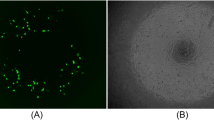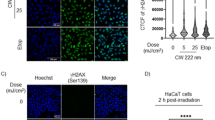Abstract
PREVIOUS investigations1 have indicated that one of the responses of cells to various injurious agents (for example, lethal ultra–violet light and X–rays) is the release into the intercellular fluids of nucleic acid–like proliferation–promoting factors (‘intercellular wound hormones’). Considerable evidence indicates that these active factors are produced in the living cell as a response to injury2. The present investigations were aimed at determining by direct observation of living cells whether there is an actual increase in cellular nucleic acids, purines or pyrimidines, during the course of injury. For this purpose, ultra–violet photomicrography was employed, following techniques well established by Caspersson3.
Similar content being viewed by others
Article PDF
References
Fardon, Norris, Loofbourow, and Ruddy, NATURE, 139, 589 (1937); Sperti, Loofbourow, and Dwyer, NATURE, 140, 643 (1937); Studies Inst. Divi Thomæ, 1, 163 (1937); Loofbourow, Dwyer, and Morgan, Studies Inst. Divi Thomæ, 2, 137 (1938); Loofbourow, Cueto, and Lane, Arch. exp. Zellforsch., 22, 607 (1939); Loofbourow, Cook, and Stimson, NATURE, 142, 573 (1938); Loofbourow, Dwyer, and Lane, Biochem. J., 34, 432 (1940).
Loofbourow and Dwyer, NATURE, 145, 185 (1940); Loofbourow, Dwyer, and Cronin, Biochem. J., in the press.
Caspersson, Skand. Arch. Physiol., Suppl. 8 (1936); Arch. exp. Zellforsch., 19, 216 (1937); ibid., 22, 655 (1938); Caspersson and Schultz, NATURE, 142, 294 (1938); ibid., 143, 602 (1939).
Heyroth and Loofbourow, J. Amer. Chem. Soc., 53, 3441 (1931); ibid., 56, 1728 (1934);. Loofbourow and Stimson, J. Chem. Soc., 846 (1940).
Mitchell, NATURE, 146, 272 (1940).
Author information
Authors and Affiliations
Rights and permissions
About this article
Cite this article
LOOFBOUROW, J., JOYCE, L. Increased Ultra–violet Absorption of Cells Following Irradiation with Ultra–violet Light. Nature 148, 166 (1941). https://doi.org/10.1038/148166a0
Issue date:
DOI: https://doi.org/10.1038/148166a0



